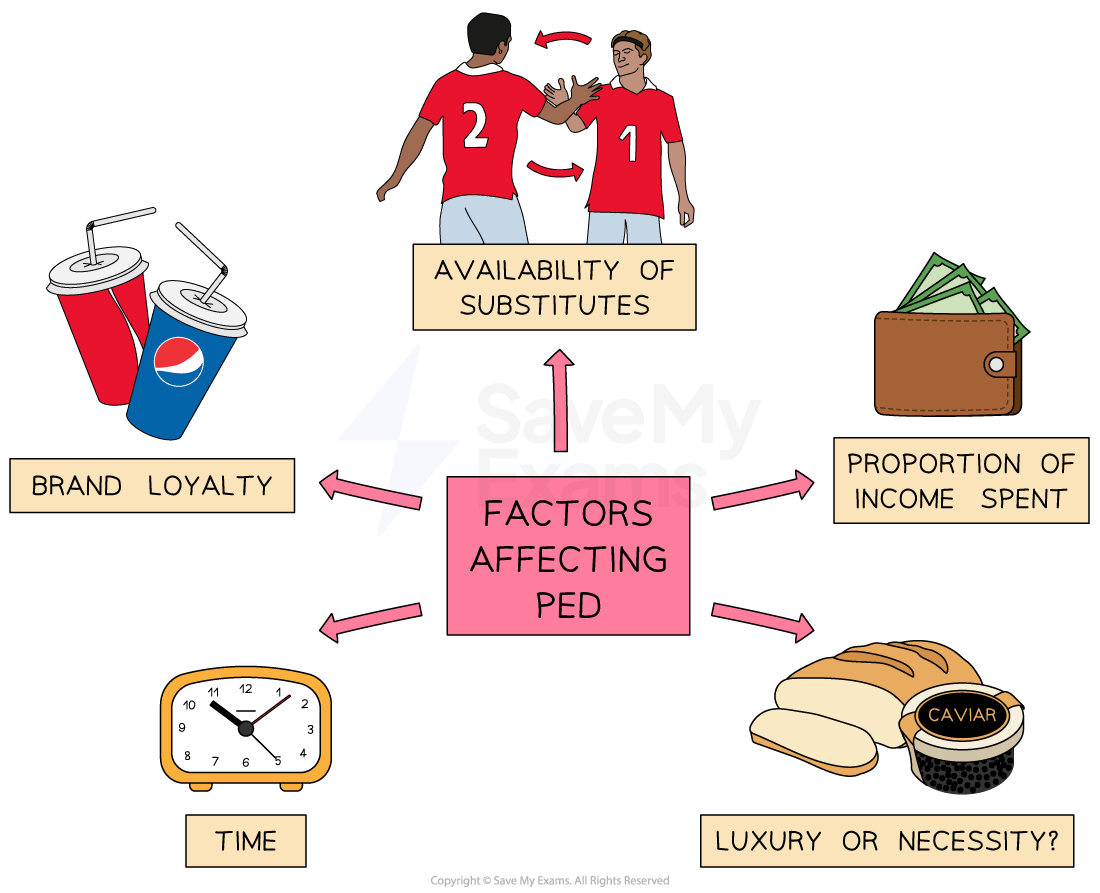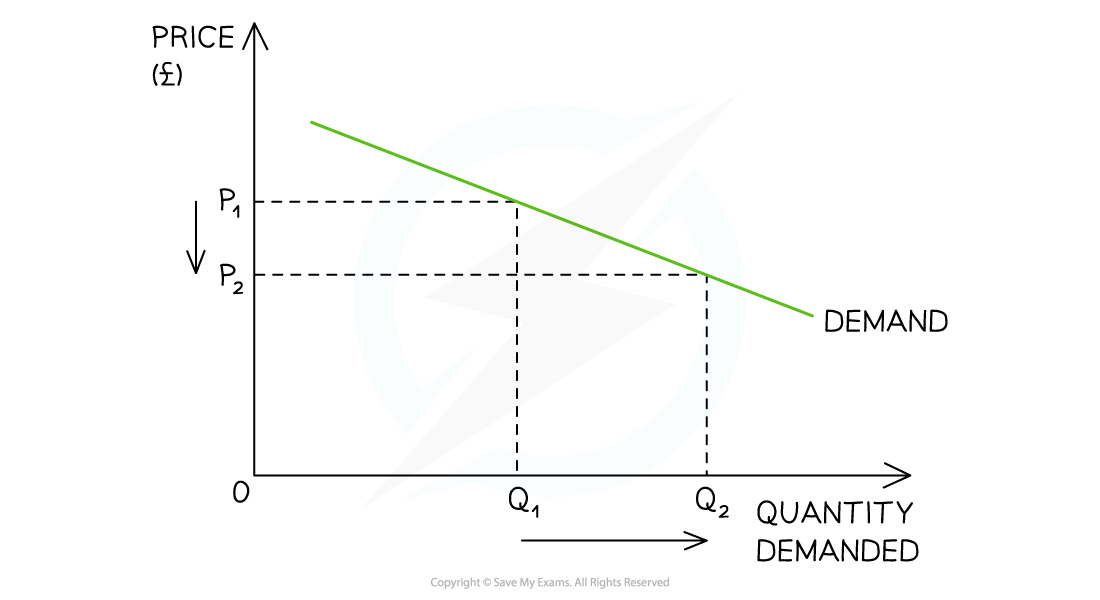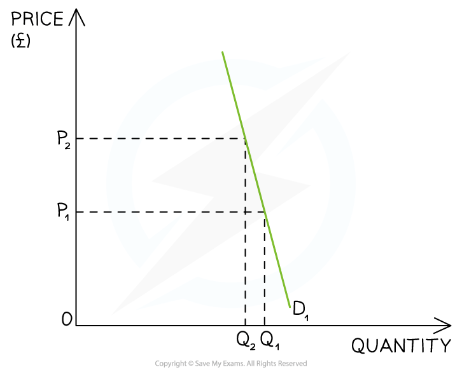Price Elasticity of Demand (PED) (Edexcel A Level Business): Revision Note
Exam code: 9BS0
An introduction to price elasticity of demand
When there is an increase in price, there will be a fall in the quantity demanded (QD), and when there is a fall in price, there will be an increase in the QD
The question businesses are interested in is "By how much will the QD change?"
The price elasticity of demand (PED) helps us to calculate how responsive the change in QD will be to a change in price
The responsiveness is different for different types of products
Calculation of PED
The PED value is always negative
PED can be calculated using the following formula:
To calculate a % change, use the following formula:
Worked Example
The PED for popcorn at the cinema is –0.8. The current price of a box of popcorn is £5. Using the data, calculate the percentage change in QD following a £1 increase in the price of a box of popcorn. You are advised to show your work.
[4]
Step 1: State the PED formula:
[1]
Step 2: Calculate the percentage change in price:
[1]
Step 3: Insert the data you have been given into the formula:
[1]
Step 4: Rearrange and solve for x:
[1]
Examiner Tips and Tricks
Remember, if the price decreases, QD increases, and if the price increases, QD decreases. In this case, price increases. Therefore, QD must fall.
Interpretation of PED numerical values
The numerical value of PED indicates the responsiveness of a change in QD to a change in price
PED will always be negative due to the inverse relationship between price and quantity
If the price goes up, the QD goes down
If the price goes down, the QD goes up
Interpretation of PED values
Numerical value | Type of good | Explanation |
|---|---|---|
-1 or lower | Elastic
|
|
Between 0 and -1 | Inelastic
|
|
Examiner Tips and Tricks
Students often confuse the negative sign in the answer to PED questions. Do not assume that the negative is mathematical, such that an elasticity of –1 is smaller than –0.3. It is larger (more price elastic).
The PED will always be negative, indicating the inverse relationship between price and QD (i.e. when the price increases, QD decreases, and when the price decreases, QD increases).
When interpreting the value of PED, do not say that "the product is elastic or inelastic"; it is better to say that "demand for the product is price elastic or price inelastic".
Factors influencing the PED

Brand loyalty
The aim of advertising and marketing expenditure by a business is to shift the demand curve to the right and make the demand more price inelastic
For example, Coke consumers are more brand loyal to Coca-Cola and refuse to buy Pepsi, even though their taste is very similar
Availability of substitutes
PED will be more price inelastic (lower) for goods that have fewer substitutes
For example, petrol has fewer substitutes and is more price inelastic, whereas chocolate bars have more substitutes and are more price elastic
The proportion of income taken up by the product
The smaller the proportion of income we spend on a product, the more price inelastic the demand will be
For example, a small amount of income is spent on salt, so the demand for salt will be more price inelastic. However, buying a new car takes up a bigger proportion of consumer income, so the PED is higher
Luxury or necessity
Necessities are required as part of consumers' daily needs, and therefore, demand for them is more price inelastic
For example, bread, milk, petrol, gas and electricity might be considered necessities
Luxuries are not essential, and therefore, demand for them is more price elastic
For example, smoked salmon, Nike Air Jordans and foreign holidays might be considered luxuries
Time
The longer the time period under consideration, the more price elastic the demand for a good or service is likely to be (consumers have more time to search for substitutes)
The shorter the time period under consideration, the more price inelastic the demand for a good or service is likely to be
For example, if the price of petrol increases, making driving more expensive, there is little that consumers can do in the short term. However, they may switch to alternatives such as public transport or bicycles in the long term
The significance of PED to businesses
If businesses can determine the PED for their products, they can adjust their pricing strategy to maximise their revenue
The relationship between PED and total revenue
Price elastic demand
If demand for their products is relatively price inelastic (PED is less than or equal to 1), raising the price will lead to an increase in total revenue. However, lowering the price will lead to a fall in total revenue

PED is greater than 1
An increase in the selling price reduces the total amount of revenue generated from sales
A reduction in the selling price increases the total amount of revenue generated from sales
Price skimming strategies are best employed for products that are price inelastic in demand
Price inelastic demand
If demand for their products is relatively price elastic (PED is greater than or less than 1), raising the price will lead to a fall in total revenue
However, lowering the price will lead to a rise in total revenue

PED is between 0 and 1
An increase in the selling price increases the total amount of revenue generated from sales
A reduction in the selling price reduces the total amount of revenue generated from sales
Competitive pricing strategies are best employed for products that are price elastic in demand

Unlock more, it's free!
Did this page help you?